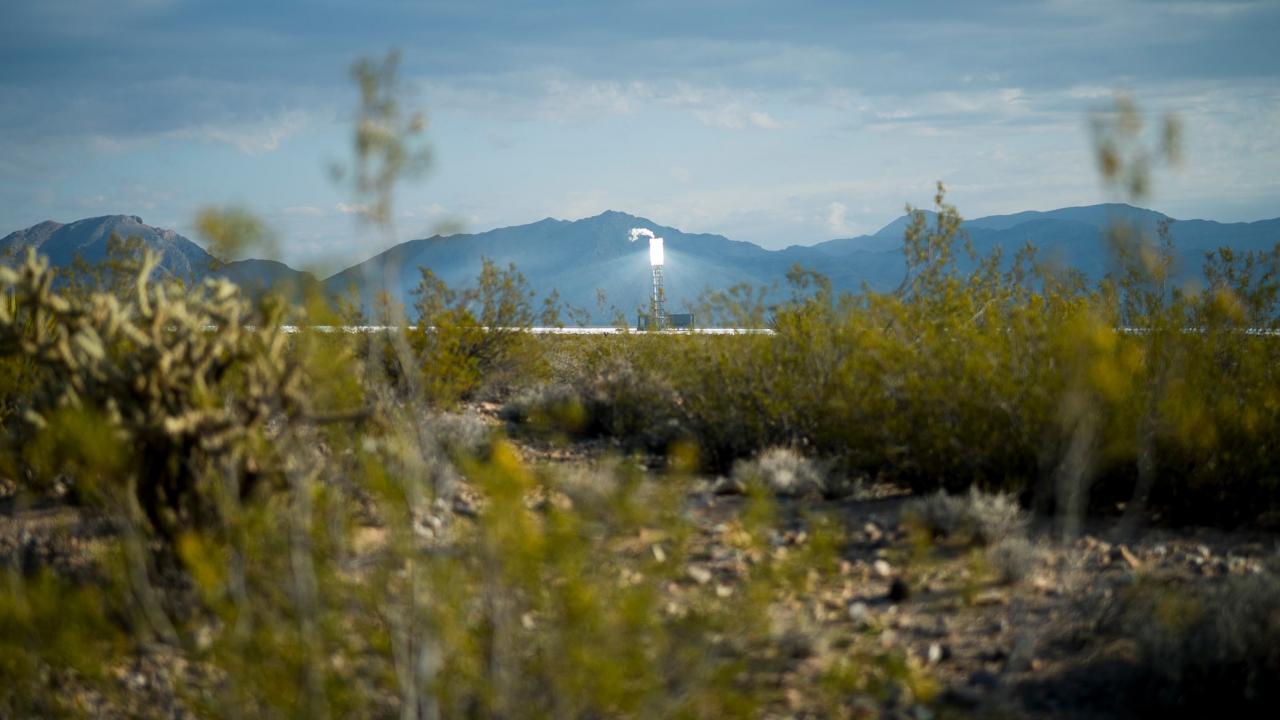Renewable energy development is vital to reduce the threats of climate change. But can solar energy development coexist with wildlife and sensitive lands?
Scientists from the University of California, Davis, are delving into that question and coming up with some promising solutions through three distinct, yet interconnected, projects.
Undoubtedly solar energy will be part of the solution in regards to the effects of climate change, but is siting solar energy installations on public lands, such as in the Mojave Desert, the best place to do so?
Project 1: Managing Wildlife
Slow and steady doesn’t win the survival race for desert tortoises
Inside a small building at the edge of California’s Mojave National Preserve, a group of baby desert tortoises has just finished a large salad of chopped chard, dandelion and mustard greens, all sprinkled with a dusting of calcium.
About 200 desert tortoises live here at the National Park Service’s Ivanpah Desert Tortoise Research Facility. The hatchlings don’t realize it, but as they digest their lunch, they’re enjoying what may be the best months of their lives. And it shows.
By wild desert tortoise standards, these babies are huge. Though just 7 months old, they are already the size of a 3- or 4-year-old tortoise in the wild.
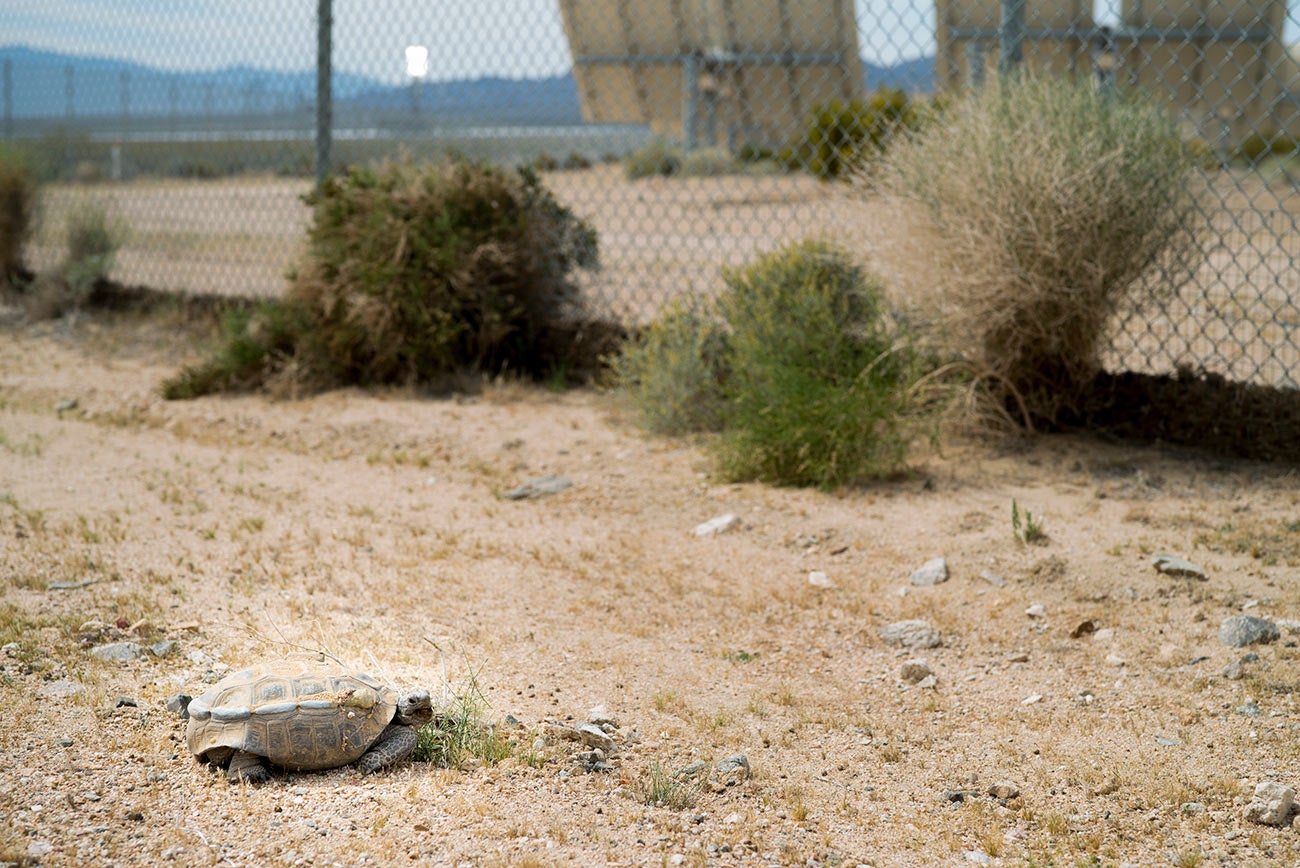
A 7-month baby tortoise in the wild is usually the size of a plump ravioli, nearly as soft, and just as appetizing to a hungry fox or raven. But here, the tiny ravioli is instead a fist-sized rock – big enough to dig its own burrow, ward off predators, hold more water, and reproduce years earlier than its wild brethren.
These tortoises are all part of a project that aims to speed the population recovery of this threatened species and give them a head start on life before they’re released to the preserve. The project is led by UC Davis professor Brian Todd in collaboration with the University of Georgia’s Savannah River Ecology Laboratory and funded in part by the California Energy Commission.
“We’re giving them an incredible childhood,” said Todd, a professor in the Department of Wildlife, Fish and Conservation Biology. “Instead of fending for themselves on the mean streets of the Mojave, where most starve to death, burn in the heat or get eaten by a raven, we keep them for a short period of time. They grow quickly because we feed them five times a week instead of a few times a year, with unlimited water. We’re getting them through the worst part of their life, essentially.”
Why all the rush?
The lifespan of a desert tortoise is similar to that of a human. They can live to be in their 80s and reach reproductive age around 15 or 16 years old. Unlike humans, however, about 99 percent of them will die within their first several years of life, long before they have a chance to reproduce.
Also unlike humans, their ability to reproduce is limited by size, not by age. If a human toddler is fed five times as much food as it’s used to each year, it becomes an obese human toddler. It doesn’t trigger puberty. But for desert tortoises, the bigger they get, the sooner they can have babies, and the sooner their population can recover.
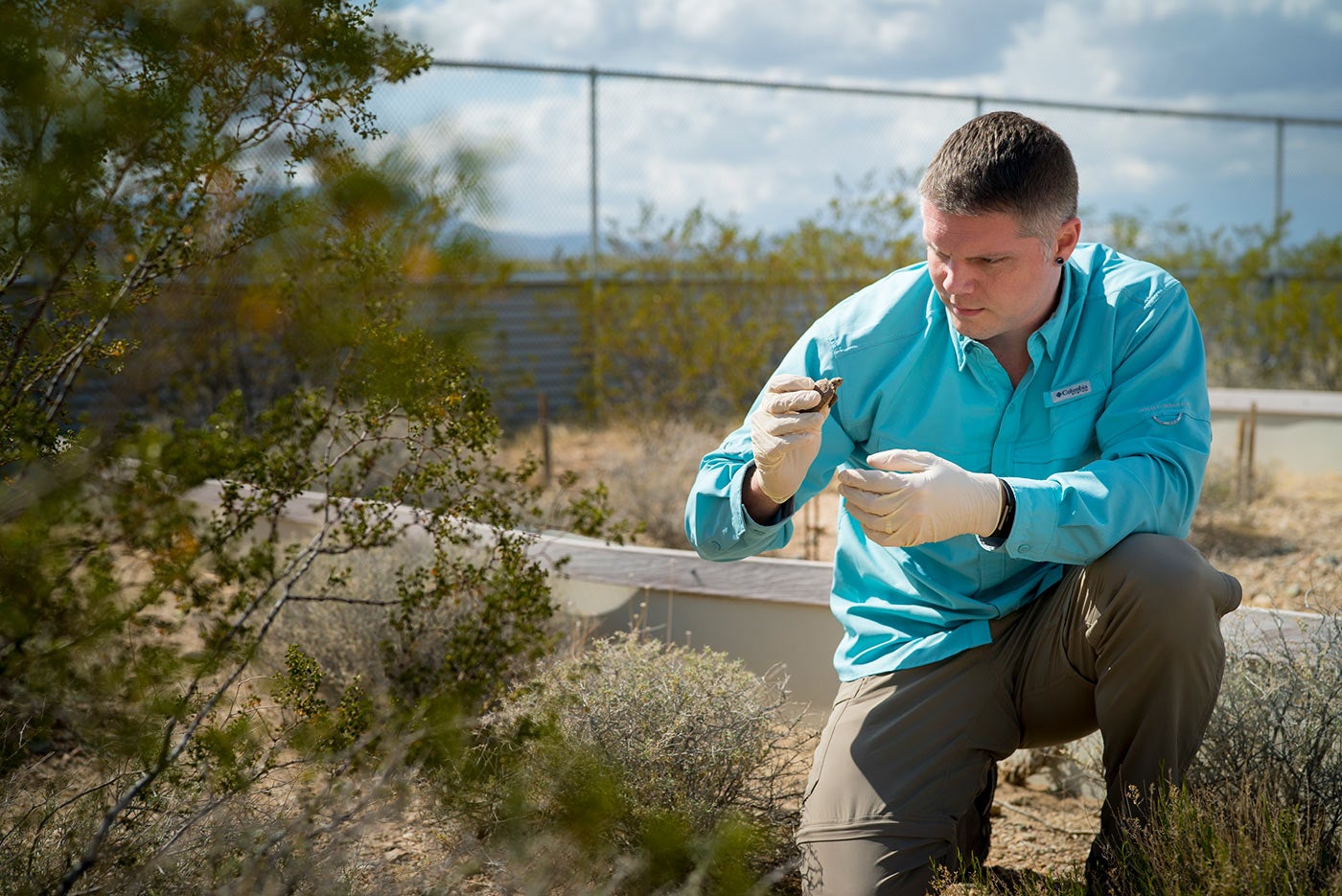
An uncertain future
If society is going to decide to allow pristine desert to be developed for these large projects, we’re going to lose some area and some species. We need to understand how we can minimize the impacts of habitat loss so there will be areas for these animals to persist.
– Brian Todd
Desert tortoises have lived in the Mojave Desert for millions of years. In the 1960s and 1970s, there were about 60 to 70 tortoises per square kilometer in the Ivanpah Valley region. Now, there are only about six or seven within that same amount of land after an upper respiratory tract disease devastated the population in the 1980s.
Roads, urban sprawl and development present further challenges to its recovery.
While development can impact tortoises, the desert tortoise now also impacts development due to its status as a federally listed threatened species. Nearby Ivanpah Solar Electric Generating System, or ISEGS, alone has spent more than $55 million on mitigation efforts for desert tortoises.
Solar energy had almost nothing to do with the species’ drastic decline, but the budding industry and urban development of the desert in general could play a significant role in its future.
As of 2009, about 240,000 acres of federal lands were approved or have pending leases for utility-scale solar energy development in the western U.S.
“We have to set aside, protect, and manage large tracts of suitable habitat to ensure that adult tortoises survive,” said project collaborator Kurt Buhlmann, who along with team member Tracey Tuberville, is a research scientist from the Savannah River Ecology Lab. “We think the key is restoring viable tortoise populations onto this human landscape where they don’t need our intervention.”
It’s a start, but there’s more to be done
So far, results have been encouraging. Most of the newly hatched tortoises are still alive after 7 years of protection. For comparison, only about 5 percent reach that age in the wild without head-starting. Ongoing work will show what advantage this early protection provides them in the wild.
The scientists caution that while the headstarting program appears to be on track to helping the tortoise population recover, it’s not a sustainable, long-term strategy for dealing with vulnerable wildlife species impacted by solar, or any other, development in the desert.
“If society is going to decide to allow pristine desert to be developed for these large projects, we’re going to lose some area and some species,” Todd said. “We need to understand how we can minimize the impacts of habitat loss so there will be areas for these animals to persist.”
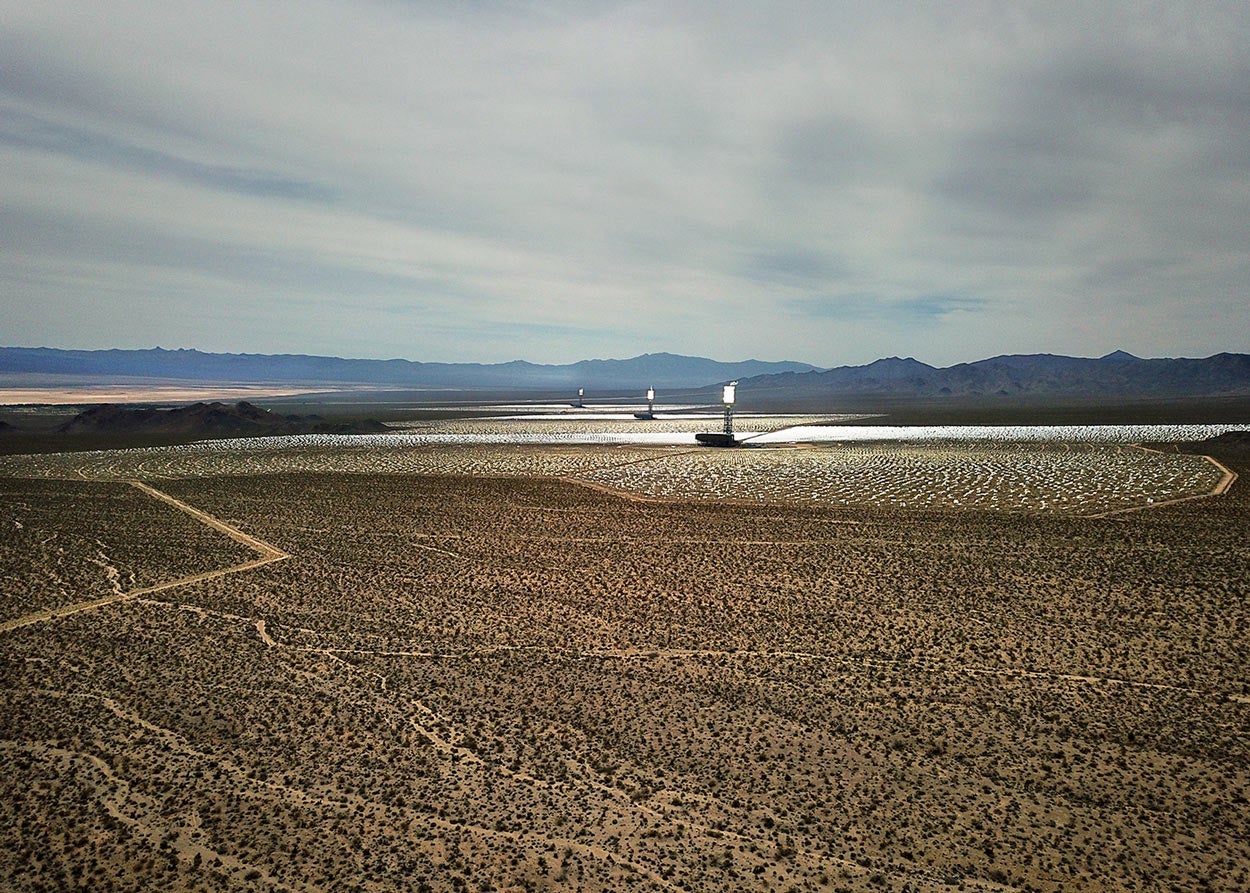
Project 2: Signs of Coexistence
Across the state line from the three-casino town of Primm, Nevada, a ripple of light spreads across the Mojave Desert. It’s bouncing off a sea of glass, steel and one of the world’s largest operating concentrated solar thermal power plants. More than 300,000 mirrors, each roughly the size of a garage door, direct light onto three massive solar towers, where steam transforms the light into solar power.
A desert tortoise sits outside the fence, staring in.
It’s quiet here but for the hum of the solar plant, the crackling of the power lines above, and the ever-present murmur of traffic on nearby I-15 headed to and from Las Vegas, just an hour to the north.
A satellite view of this place appears brown and barren. But step inside, and signs of life are everywhere: in the bounding jackrabbit, the scampering lizard, the bird song, the scorpion spied in the night, the thousands of holes leading to underground creature communities.
From the freeway looking at the expanse of the Ivanpah Solar Electric Generating System, it’s hard to imagine that somewhere within these 4,000 acres of cacti and mirrors, an ecologist is on his belly, looking under the leaves of a rare plant for butterfly eggs.
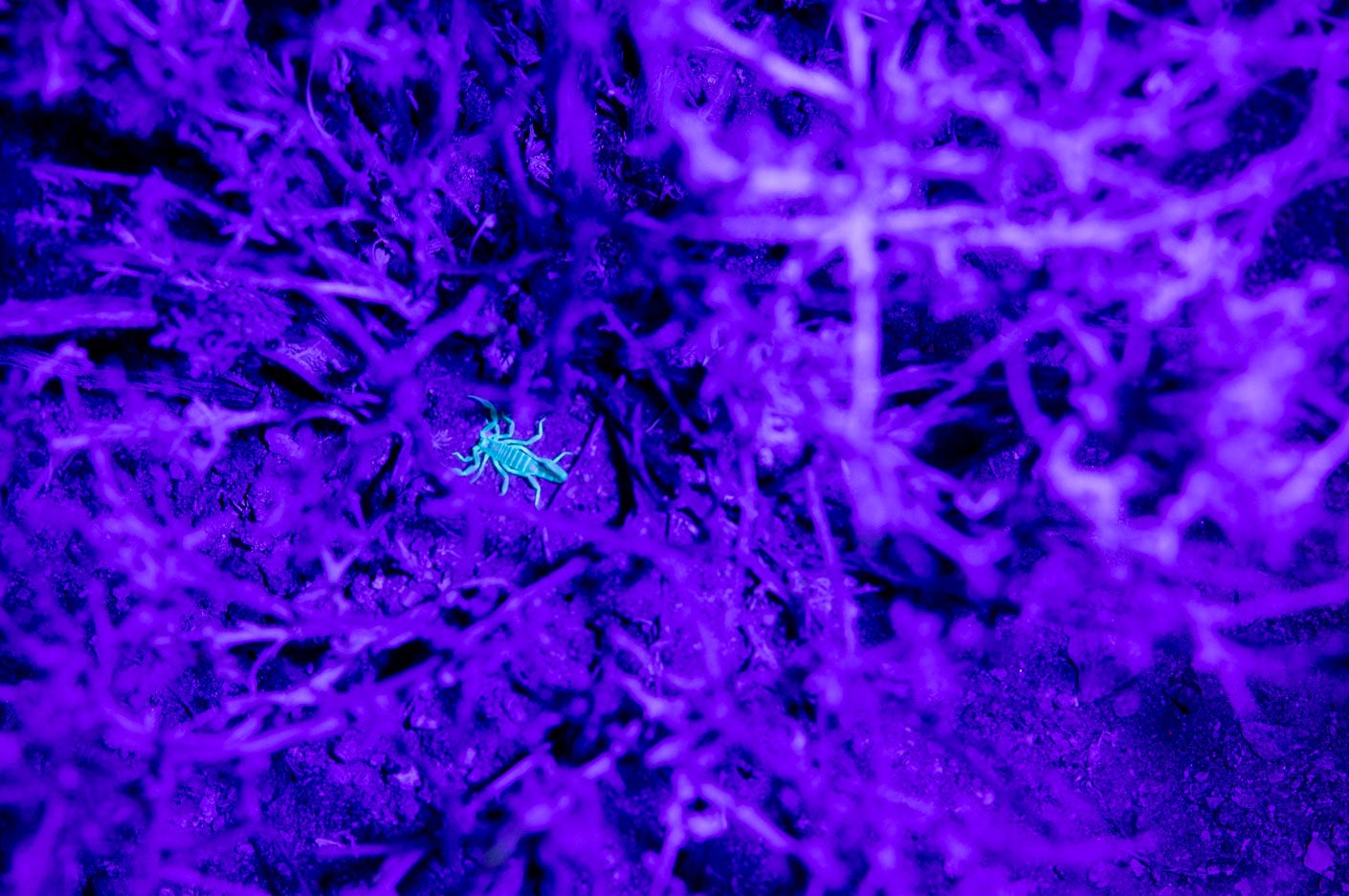
Milkweed, butterflies and more
The rare plant is the Mojave milkweed. The butterfly is the queen butterfly, nearly identical to another royal butterfly, the monarch. The ecologist is Steve Grodsky, a UC Davis postdoctoral scholar in professor Rebecca R. Hernandez’s AridLab. Together they co-direct the Wild Energy Initiative, a project of the UC Davis John Muir Institute of the Environment.
“I’m not seeing any eggs here,” he says looking up from the ground. “But the plants are looking good.”
Queen butterflies rely on Mojave milkweed for their existence. They are born on the plant and lay their eggs on it. Once hatched, the caterpillars live on the milkweed, which imparts a chemical defense upon them that makes them unappetizing to birds.
Grodsky is researching how the solar facility’s mirrors, which cast shade and redirect rainfall on the landscape, affect interactions among the soil, plants and wildlife, including the milkweed and these butterflies.
Cameras throughout the facility and at nearby control sites catch interactions on milkweed plants, insect traps, and wildlife dens. Sensors measure soil temperature and humidity to note changes inside and outside of the facility.
“The system we’re looking at could shed light on more than just butterflies and plants,” Grodsky said. “It could also give us an idea for how desert plants and animals in general might be adapting to concentrating solar power facilities. We’re trying to guide sustainable development moving forward.”
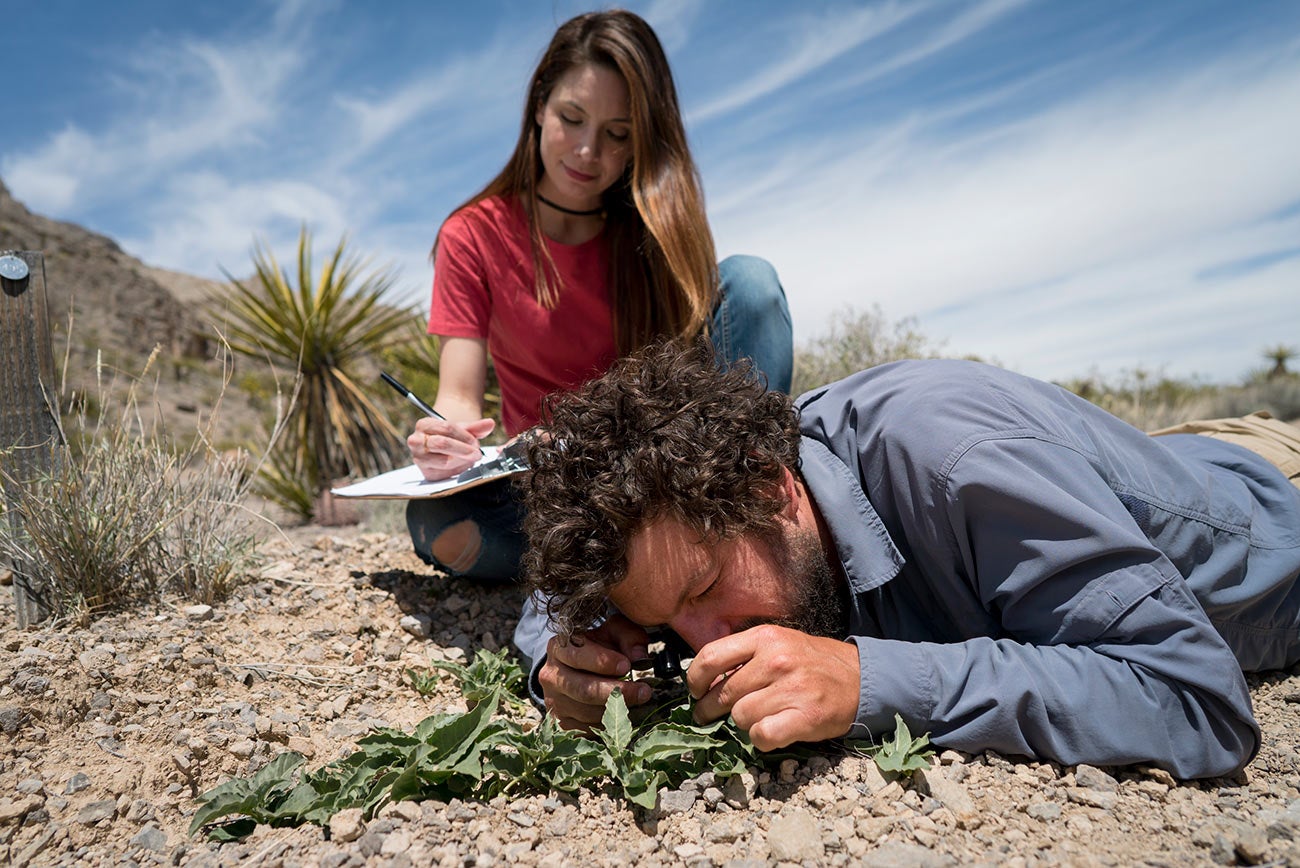
Winners and losers
So far, Grodsky is finding signs of coexistence.
The milkweed, for example, seems to be growing well. Grodsky has also observed desert kit foxes inside the solar facility. They appear to be benefiting from the shade cast by the mirrors and by the protection from coyotes the fence around them affords. Meanwhile, burros, cattle and desert tortoises are also excluded by the fence, leaving vegetation inside to feed blacktail jackrabbits, which kit foxes like to eat.
“We are seeing patterns that indicate effects of the solar facility on the wildlife,” Grodsky said. “Sometimes they’re positive effects, and other times they’re negative. Whether you’re dealing with wind, hydropower or solar energy, there are going to be winners and losers in terms of species.”
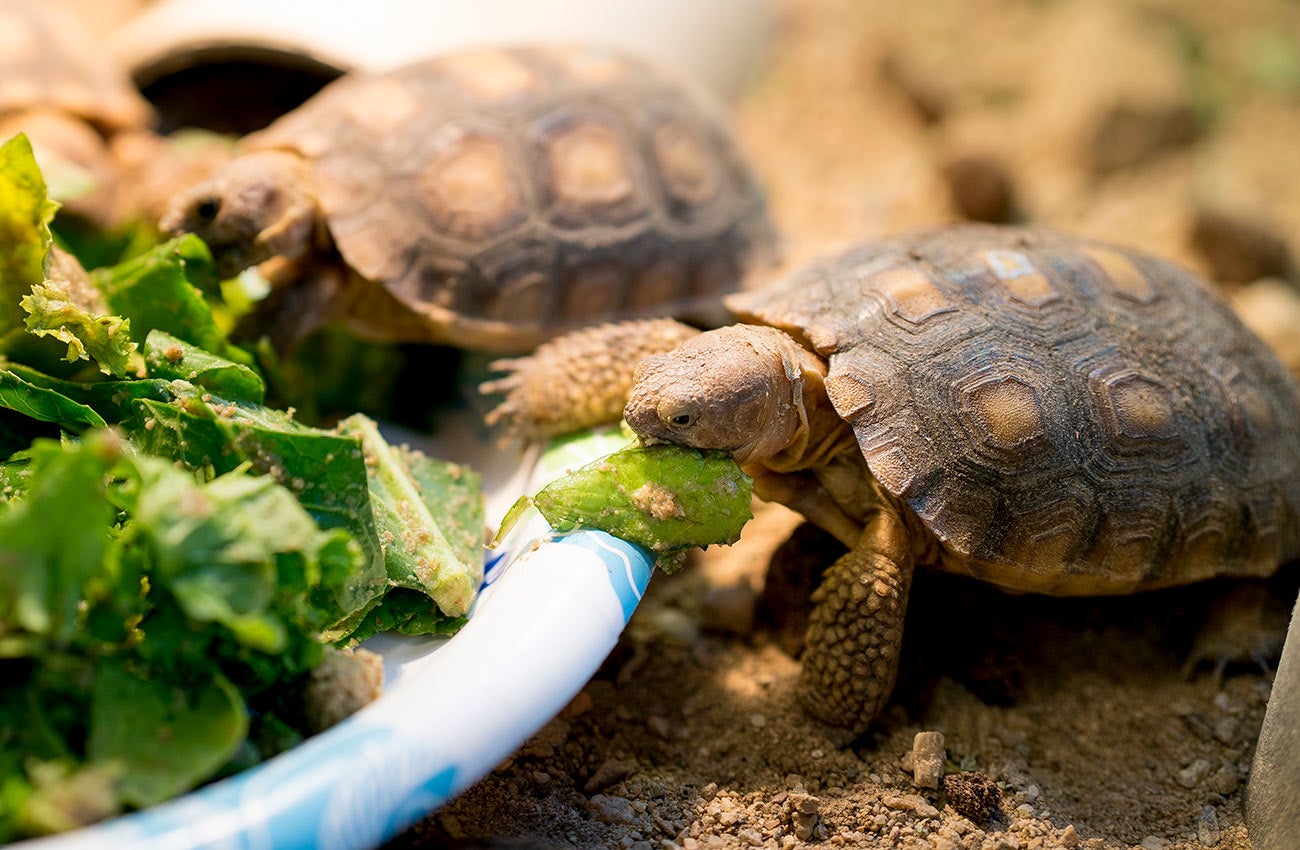
Sustainable strategies for solar development
Thoughtful design may have helped enable cases of coexistence at the solar facility. Some utility-scale solar facilities use bulldozers to scrape layers of earth away from the site. But ISEGs mowed most of the site, allowing vegetation to regrow beneath the mirrored panels.
It also scattered “halos” across the facility. These are roped off, mirrorless areas known to hold sensitive species. Grodsky has been testing their effectiveness for protecting wildlife here, and they appear to be encouraging pockets of coexistence.
But Grodsky said the greatest tool renewable energy developers and policymakers have to help ensure coexistence with wildlife, is smart, sustainable siting from the beginning.
“I don’t think any ecologist in their right mind would be against renewable energy development,” Grodsky said. “There are ways we can site solar facilities that might lessen the impact on wildlife communities. But ultimately, I think we need to move away from developing renewable energy on undeveloped lands. There are plenty of marginalized lands where the ecological impacts would be far less.”
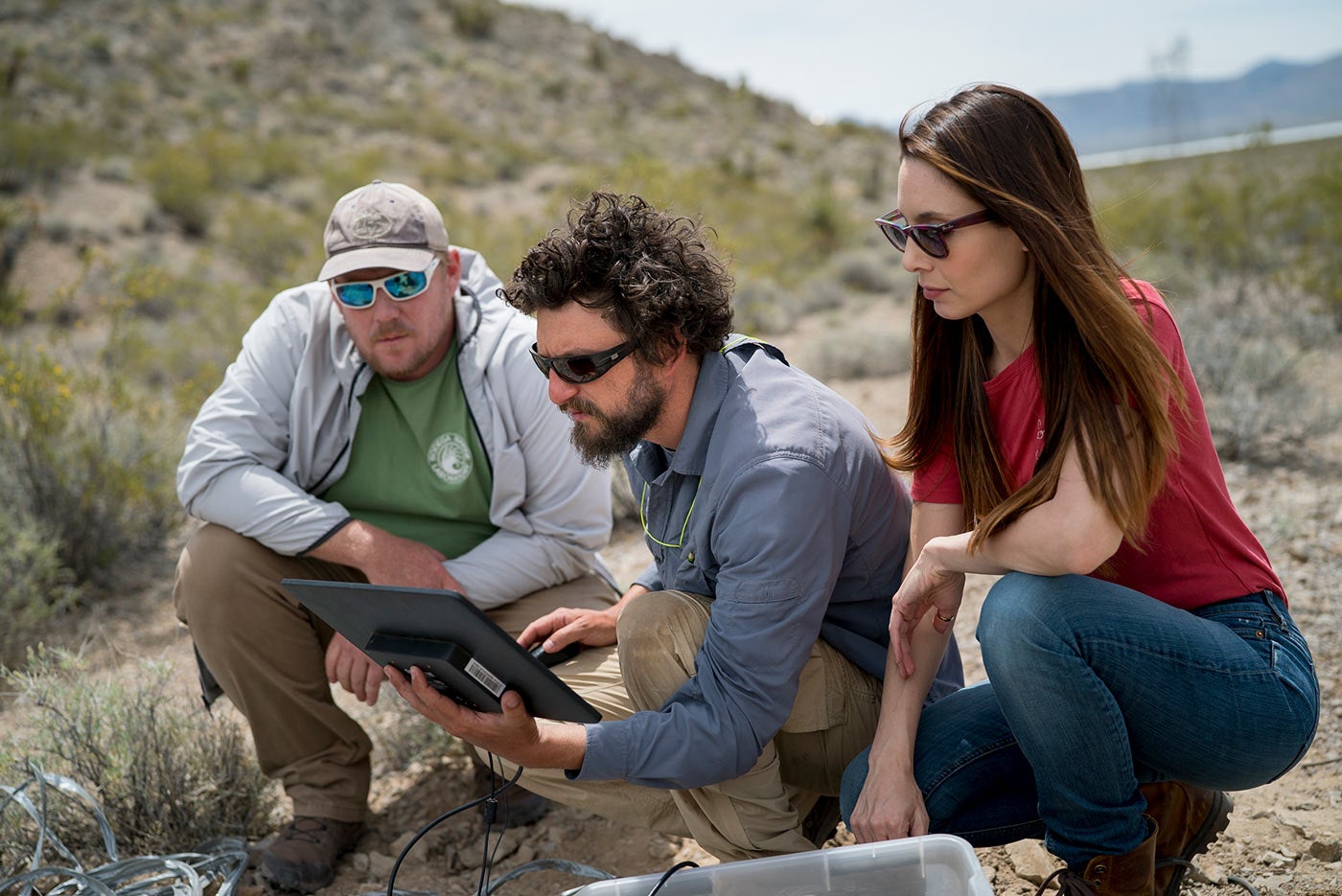
Project 3: Take it to the Roof
So where can we put solar energy without hurting the environment?
Lots of places, according to research from Hernandez’s lab: former landfills, superfund sites, already disturbed public lands, and, perhaps most promising, existing rooftops.
Forty percent of all energy consumption in the U.S. is associated with buildings. But, with the right incentives in place, buildings could become one of the largest renewable energy producers.
Hernandez and UC Davis environmental scientist Esther Wence are modeling the solar energy potential of the 30 biggest commercial buildings in the United States and estimating how much land could be spared and carbon emissions saved with those installations.
The buildings include major retailers with some of the biggest warehouses and factories in the country.

Miles of rooftop
The 30 buildings make up about 9 million square meters. That doesn’t include their parking lots, which would double the figure if solar were mounted on carports. Taken together, that’s larger than the Ivanpah solar facility. It’s like blanketing every inch of downtown Los Angeles with solar energy systems without having to displace wildlife, agriculture or natural lands.
Large U.S. companies installed about 326 megawatts of solar panels in 2017, which was 2 percent more than in 2016, according to the Solar Energy Industries Association. Yet, of the 30 biggest buildings, none currently have solar on the roof, though installations are underway in a handful of locations.
“The number and size of commercial buildings have increased dramatically over the past couple of decades,” Hernandez said. “Let’s take a step back and ask, ‘How can we use this?’ Answering that question could have a huge impact not only on emissions, but also on the environmental impacts associated with water, wildlife and land.”
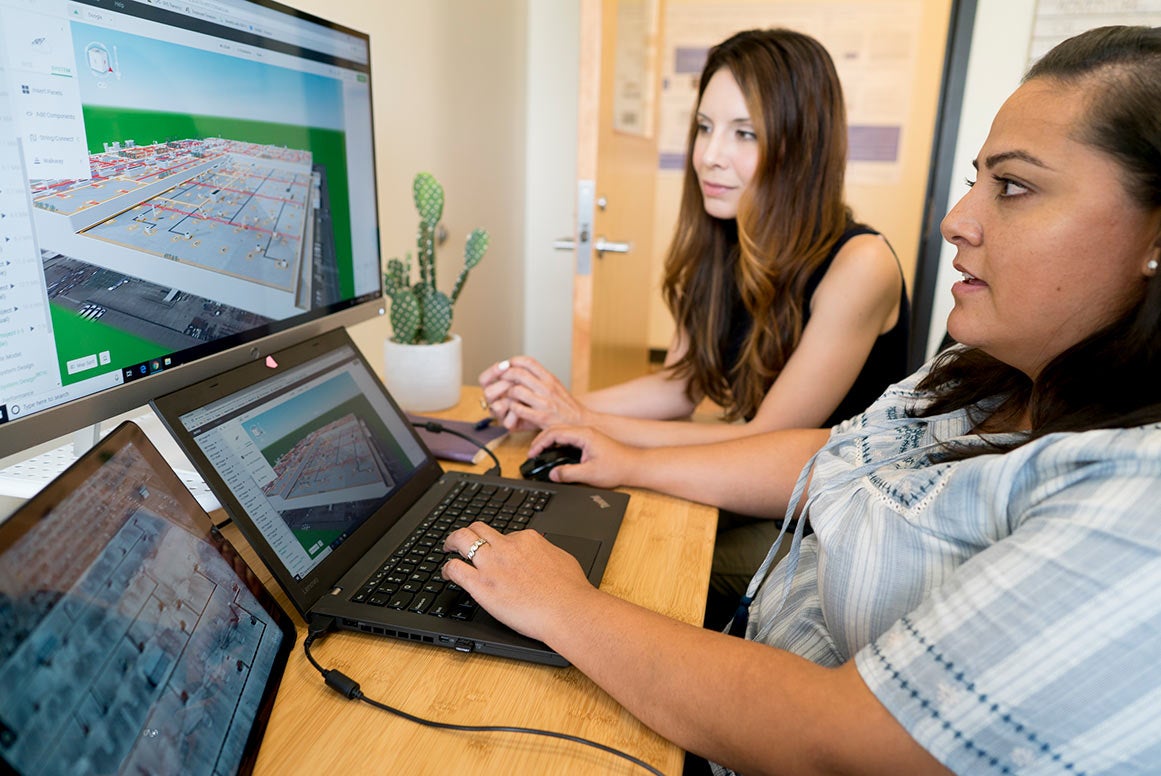
Real-world estimates
In collaboration with renewable energy specialist Greer Ryan at the Center for Biological Diversity, the scientists have been putting a cloud-based solar design tool called Aurora Solar to the task of modeling these buildings down to the cell-string level. Wence is accounting for real-world factors like building and fire code requirements, rooftop obstructions like skylights and HVAC systems, and the solar resources available in each geographic region.
Such planning, software access, and expertise would cost a private company thousands of dollars in upfront costs and can be a barrier to installing solar energy, yet the results will be publicly available once the project is complete. Essentially, Hernandez and Wence are handing realistic designs and estimates to these individual companies and the public.
Thinking on top of the box
While the scientists are still crunching the data on the full top 30, a preliminary look at the top two is promising:
At number one is a global aerospace company in Fort Worth, Texas, where various buildings make up about 770,000 square meters of rooftop. The main building alone is roughly the size of 49 football fields and can generate up to 88 million kilowatt hours of clean energy. That’s enough to power nearly 5,200 homes for a year; offset 47,800 metric tons of CO2; and spare up to 388 acres of land.
An airplane assembly factory in Everett, Washington is ranked second. The rooftop footprint for its main building is as large as about 74 football fields and could produce enough energy to power 5,169 homes for a year; offset 47,800 metric tons of CO2; and spare up to 543 acres.
“I think we’ve already taken enough land for our needs,” Wence said. “We need to think outside the box, or actually, we need to get on top of the box with existing buildings.”
“But people have to want it,” Hernandez adds. “People have to say, ‘This is where we want our power plants to be,’ not in places where you have to translocate desert tortoises.”
Media Resources
Kat Kerlin, UC Davis News and Media Relations, 530-752-7704, kekerlin@ucdavis.edu
